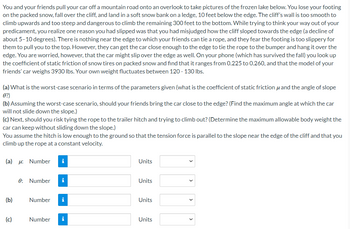Question

Transcribed Image Text:You and your friends pull your car off a mountain road onto an overlook to take pictures of the frozen lake below. You lose your footing
on the packed snow, fall over the cliff, and land in a soft snow bank on a ledge, 10 feet below the edge. The cliff's wall is too smooth to
climb upwards and too steep and dangerous to climb the remaining 300 feet to the bottom. While trying to think your way out of your
predicament, you realize one reason you had slipped was that you had misjudged how the cliff sloped towards the edge (a decline of
about 5-10 degrees). There is nothing near the edge to which your friends can tie a rope, and they fear the footing is too slippery for
them to pull you to the top. However, they can get the car close enough to the edge to tie the rope to the bumper and hang it over the
edge. You are worried, however, that the car might slip over the edge as well. On your phone (which has survived the fall) you look up
the coefficient of static friction of snow tires on packed snow and find that it ranges from 0.225 to 0.260, and that the model of your
friends' car weighs 3930 lbs. Your own weight fluctuates between 120 - 130 lbs.
and the angle of slope
(b) Assuming the worst-case scenario, should your friends bring the car close to the edge? (Find the maximum angle at which the car
will not slide down the slope.)
(a) What is the worst-case scenario in terms of the parameters given (what is the coefficient of static friction
0?)
(c) Next, should you risk tying the rope to the trailer hitch and trying to climb out? (Determine the maximum allowable body weight the
car can keep without sliding down the slope.)
You assume the hitch is low enough to the ground so that the tension force is parallel to the slope near the edge of the cliff and that you
climb up the rope at a constant velocity.
(a) : Number
(b)
(c)
0: Number
Number
i
i
i
Number i
Units
Units
Units
Units
Expert Solution
This question has been solved!
Explore an expertly crafted, step-by-step solution for a thorough understanding of key concepts.
This is a popular solution
Trending nowThis is a popular solution!
Step by stepSolved in 5 steps

Knowledge Booster
Similar questions
- Calculate the resultant ground reaction force during the inital contact phase (to the nearest whole number) given the following data vertical force Z =995 N and horizontal force X = -261 N Answer e to search E D Check C R F V Bi T G St 6 B H N J 8 M L O P₂ P ? ctri greeus / 3 pause 5°C Mostly cloudy # lock 7 home 4 Next page 1 12:15 30/11/2023 8arrow_forwardThree identical balls (ball 1, ball 2, and ball 3) are thrown at the same speed from the top of the same building. Ball 1 is thrown downward at 45 ° below the horizontal, ball 2 is thrown horizontally, and ball 3 is thrown upward at 45 ° above the horizontal. Which ball is going fastest just before it hits the level ground below the building (i.e., has the largest impact speed)? Assume air drag on the balls is negligible.arrow_forwarda tire swing is hanging from a rope of the length 5 meters long. It swings from an initial angle of 30 degrees relative to the vertical. The mass of the tire is 19k. what is the maximum tensionarrow_forward
arrow_back_ios
arrow_forward_ios